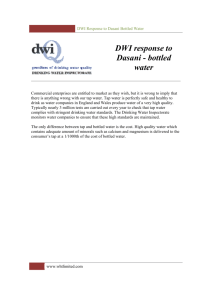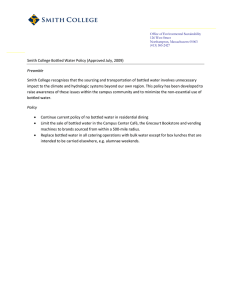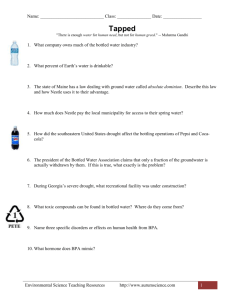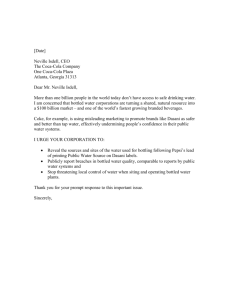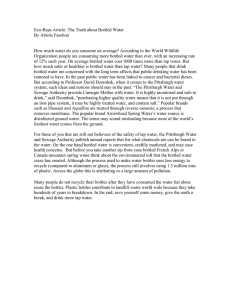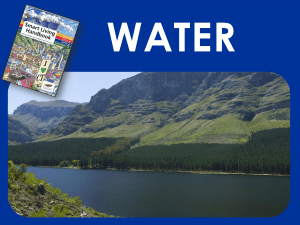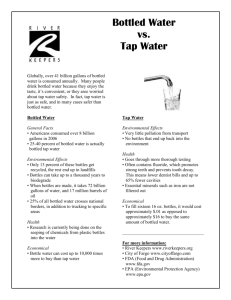BOTTLED WATER: BACKGROUND, HISTORY, AND ARGUMENTS
advertisement
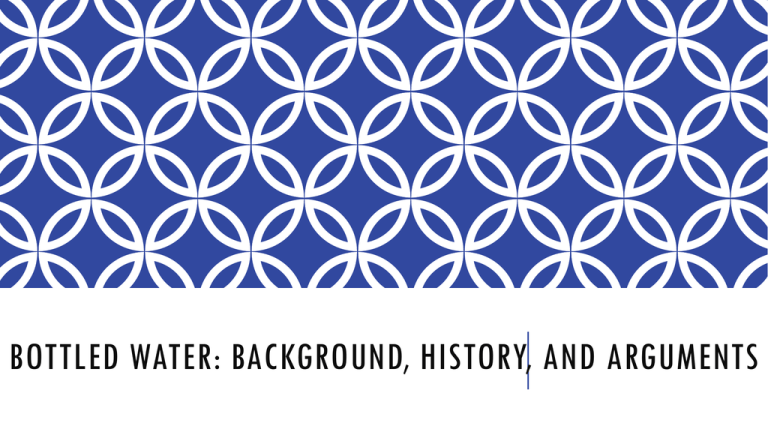
BOTTLED WATER: BACKGROUND, HISTORY, AND ARGUMENTS BOTTLED WATER: BACKGROUND, HISTORY, AND ARGUMENTS Learning Goal: I will be able to understand the history of bottled water and recognize the tension between its convenience and the impact that can have on our state and environment Sources: https://digital.library.txstate.edu/bitstream/handle/10877/3296/fulltext.pdf?sequence=1 and http://www.npr.org/templates/story/story.php?storyId=126833795 Quick History of Bottle Water: •1845- Earliest modern bottled water company in the US The Ricker family of Maine bottled and sold spring water- capitalizing on the spring’s supposed medicinal properties, eventually becoming the Poland Springs water company. •1905- Ozarka Spring Water Company was founded in Eureka Springs, Arkansas. •1958- International Bottled Water Association- Bottling companies formed their own lobbing group to promote their product and set standards for health •1976- The average American consumed a gallon and a half of bottled water each year. Around 350 million gallons of bottled water were sold in the US (almost entirely sparking mineral water and large bottles to supply office water coolers) •1977- Perrier launched a $5 million marketing campaign in the United States for its imported water; as it took advantage of concerns about pollution and poor-quality tap water, •Between 1980 and 2006, data on beverage consumption reveals that on average, each of us is actually drinking around 36 gallons/year less tap water. Over this same period of time, our consumption of carbonated soft drinks has grown by 17 gallons per person per year Our consumption of bottled water has grown by 25 gallons per person per year Our purchases of all other beverages, including milk, juices, beer, tea, coffee, and hard liquor have dropped by 6 gallons per year. •By 2008, number of bottled water per person/year in the US had grown to about 30 gallons. Americans now drink more bottled water than milk or beer Nearly 9 billion gallons of bottled water were packaged and sold in the US and 5x this amount was sold around the world, feeding a global business of water providers, bottlers, truckers, and retailers at a cost to consumers of over a hundred billion dollars. •2012- Americans spent $11.8 billion dollars on bottled water •The next big thing in bottled water: Boxed Water is Better Company (Grand Rapids, Michigan) uses milk carton-like boxes as an environmentally friendly alternative to plastic bottles. (24 cartons for $39.00) Ethical Question(s): 1. Should companies be allowed to commercially sell bottled water knowing the impact it can have on communities and their environment? 2. Should Nestle be allowed to build a bottled water plant in Cascade Locks, Oregon? Proponents: (YES! to Bottled Water) 1. Convenient Easily transported to hand out during disasters Portable- Easy to carry with you to consume whenever 2. Source of Safe, Clean Drinking Water Not all communities have clean drinking water (ex: Flint Michigan) Tap water contamination concerns- is it really pure? Due to the fact that the water is usually bottled at its source, it can avoid the possible contamination that could result in city treatment processes (IBWA, 2006) One of Brita's advertising campaigns claimed that a Brita filter "turns tap water into drinking water." 3. Jobs Water is a natural resource; just timber, oil, etc.; states should be able to sell it. Opponents: (NO! to Bottled Water) 1. Pollution Plastic in OceanGreat Pacific Garbage Patch About 80% of the debris in the Great Pacific Garbage Patch comes from land-based activities in North America and Asia. Great Garbage Patch Plastic in landfills 30 million bottles thrown away every day; they will take a thousand years to biodegrade CO2 emissions (Carbon footprint bottled vs. tap) Once purified, water is frequently sold far away from its source (23.5 billion tons/year worldwide); so must be transported, which is done entirely without pipelines, and so relies entirely on fossil fuels. Oil consumption Millions of tons of plastic bottles are produced every year, using 1.5 million barrels of oil for the US alone. 2. Right to Clean Water (Companies can’t buy it all up) Bottled water is expensive; Tap water is clean and affordable Citizens in the United States have access to clean water, courtesy of extensive public works programs, but if that water was bottled the cost would be roughly $16,000, compared to the $60 charge for municipal water per month. Many brands, particularly the largest brands like Dasani and Aquafina are simply filtered tap water. Equal Access (cultures believe that it is unethical to put a price tag on a resource everyone should have access to) 3. Water is a Valuable and Limited Resource Allowing large corporations to package water and take it out of the community will: Make the effects of a drought more heavily felt (Nestle and San Bernardino National Forest) Will decrease the amount of water available for farms, orchards, and fisheries HW: Think about the Ethical Questions and on the pink exit slip, come up with 5 questions that you have/what information you would need to know in order to answer the ethical questions.
